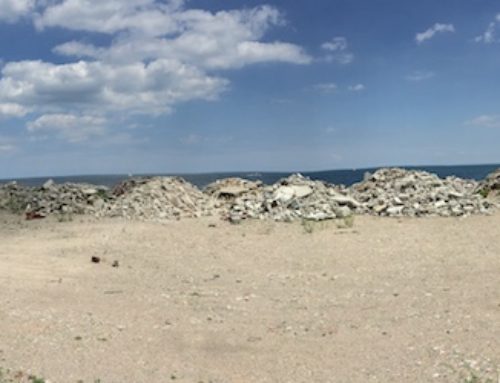Summary
The Transforming your Practice Integrated Design Charrettes for Sustainable Buildings Toronto Charrette took place over one-and-a-half days at the City of Toronto’s Metro Hall on the afternoon of November 7th and all day on November 8th, 2001.
The objective of the Toronto Charrette event was to use the integrated design process (IDP) to push the boundaries of building performance towards more sustainable practices. The event was designed to take professionals through an IDP of a new development so they would “learn by doing”, with the hopes of future implementation of the IDP in their own practice. During the event a variety of techniques such as solar walls, green roofs and gray water recovery were used by design teams to meet energy efficiency goals of 25-75% above the Model National Energy Code for Buildings (MNECB). Improvements to air quality, water usage, and aesthetics were also achieved.
Green roofs, gray water, and solar walls: just a few of the techniques used by these design teams.
The use of the Radio City development on the old CBC lands in Toronto provided participants with a practical design problem, a sense of tangibility and context in the market place. Another key element to the success of the event was the integrated focus. The charrettes required representation of the many different professionals that are related to building development.
Six design teams were established to work on the site, three to explore multi-unit residential buildings (MURB) and three to explore office design issues of a commercial residential mixed-use building. Three levels of constraint and performance were proposed to challenge the six design teams:
- Design teams “A” – were constrained in orientation, geometry, size and site; essentially using the building as designed. The performance goals were to design the building, subject to constraints, with a minimum energy efficiency improvement of 25%.
- Design teams “B”- were constrained by the geometry and site, allowing for additions to the developed scheme, changes in orientation and materials. The performance goal, subject to these constraints, was to achieve at least 50% improvement in energy efficiency over the MNECB.
- Design teams “C” – were constrained by site only. The performance goal, subject to this constraint, was to achieve at least a 75% improvement in energy efficiency over the MNECB.
In order to be able to experiment with a diverse range of building design features and estimate the results of using such features within a design context EE4 CBIP software package was used. Using this software enabled the teams to assess how their design considerations would influence the energy use of the designed building. EE4 CBIP was initially developed for Natural Resource Canada’s Commercial Building Incentive Program (CBIP).
Through a combination of measures MURB Team A managed to improve the energy efficiency of the building by over 48%, exceeding the target of 25%. The incremental cost for these measures was less than 1% of the buildings capital cost. These measures are expected to produce annual energy cost savings of $60 000. The final results of MURB Team B’s building design improved the energy efficiency of the building by over 50%. The team estimated that the measures would cost $1 543 500 and would produce an annual energy savings cost of $60 000, representing a payback period of 20 years. The final results of MURB team C’s building design, whose only constraint was site, improved energy efficiency by 75% above MNCB standards.
Office Team A generated two building designs to meet their performance goal of 25% improved energy efficiency. The SPEC model increased energy efficiency by 43% with an estimated overall cost savings of 1.05 $/ft2. While the “Purpose Built Scenario”, including all SPEC measurements as well as several other additions, created an estimated 53% overall energy savings. Office Team B improved energy efficiency of the building by 79.6%. Office Team C through a combination of lighting, equipment, heating and cooling, ventilation and water measures managed to meet their design team challenge to improve the energy efficiency of the building by 75%.
All teams were given a questionnaire to fill out at the end of the session. The questionnaire gauged the participants previous knowledge of IDP and green design, previous levels of experience with various design tools, guides and processes, their feedback on the charrette, and their intentions to use the integrated design process and/or whole building energy simulation in the future. Most participants found that the charrettes met or exceeded their expectations and that they gained some insight that will be useful in their work. Not only did the charrettes provide an opportunity to participate in an integrated design team, but they also provided the opportunity to design modifications to an actual proposed development in the City of Toronto. This made the design experience more practical and rewarding.
The event was organized by Canada Mortgage and Housing Corporation (CMHC) and supported by:
- Enbridge Consumers Gas, (now Enbridge Gas Distribution)
- City of Toronto’s Better Buildings Partnership (BBP),
- Natural Resource Canada’s Office of Energy Efficiency, and
- Canadian Energy Efficiency Alliance (CEEA).
Main report: ![]() Transforming your practice (PDF, 974 kb)
Transforming your practice (PDF, 974 kb)
Appendices: ![]() Transforming your practice appendices (PDF, 1681 kb)
Transforming your practice appendices (PDF, 1681 kb)
Contents
Acknowledgements, Partners, Experts, Professional Associations, Funders, Volunteers
1 Background
1.1 Charrette Objective: Use IDP to Implement Sustainable Practices.
1.2 Planning
1.2.1 The Integrated Design Process (IDP)
1.2.2 The Project
1.2.3 Design Challenge
1.3 The Integrated Design Charrette
1.3.1 Teams
1.3.2 Resource Material
1.3.3 Description of Day 1
1.3.4 Description of Day 2
2 Results
2.1 Background on Energy Simulations
2.2 MURB Base-case
2.3 MURB Team A
2.3.1 Design Challenge and Constraints
2.3.2 Approach to Integrated Design Process
2.3.3 Design Measures Considered
2.3.4 Final Results and Analysis
2.4 MURB Team B
2.4.1 Design Challenge and Constraints
2.4.2 Approach to Integrated Design Process
2.4.3 Design Measures Considered
2.4.4 Final Results and Analysis
2.5 MURB Team C
2.5.1 Design Challenge and Constraints
2.5.2 Approach to Integrated Design Process
2.5.3 Design Measures Considered
2.5.4 Final Results and Analysis
2.6 Office Base-case
2.7 Office Team A
2.7.1 Design Challenge and Constraints
2.7.2 Approach to Integrated Design Process
2.7.3 Design Measures Considered
2.7.4 Final Results and Analysis
2.8 Office Team B
2.8.1 Design Challenge and Constraints
2.8.2 Approach to Integrated Design Process
2.8.3 Design Measures Considered
2.8.4 Final Results and Analysis
2.9 Office Team C
2.9.1 Design Challenge and Constraints
2.9.2 Approach to Integrated Design Process
2.9.3 Design Measures Considered
2.9.4 Final Results and Analysis
3 Participant Feedback
3.1 Previous Knowledge of IDP and Green Design
3.2 Previous Experience with Design Tools
3.3 Charrette Feedback
3.4 Future Use of IDP and Whole Building Energy Simulation
3.5 Written Testimonials and Other Feedback
3.5.1 Developer: Alex Speigel, Context Development Inc.
3.5.2 Energy/HVAC Specialist: Larry Brydon, OZZ Corporation
3.5.3 Note-taker: Arran Timms
3.5.4 Other Feedback
4 Conclusions
Appendices
The appendix document includes:
Appendix A: Biographies of Experts
Appendix B: Overview of an Integrated Design Process
Appendix C: Charrette Event Site Plans
Appendix D: Charrette Event Agenda
Appendix E: Charrette Event Attendee List
Appendix F: Charrette Event Day 1 Plenary Presentations
Appendix G: Analysis of a Cogeneration System
Appendix H: Attendees Questionnaire
Appendix I: Written testimonials
Posted: 2002-09-05






